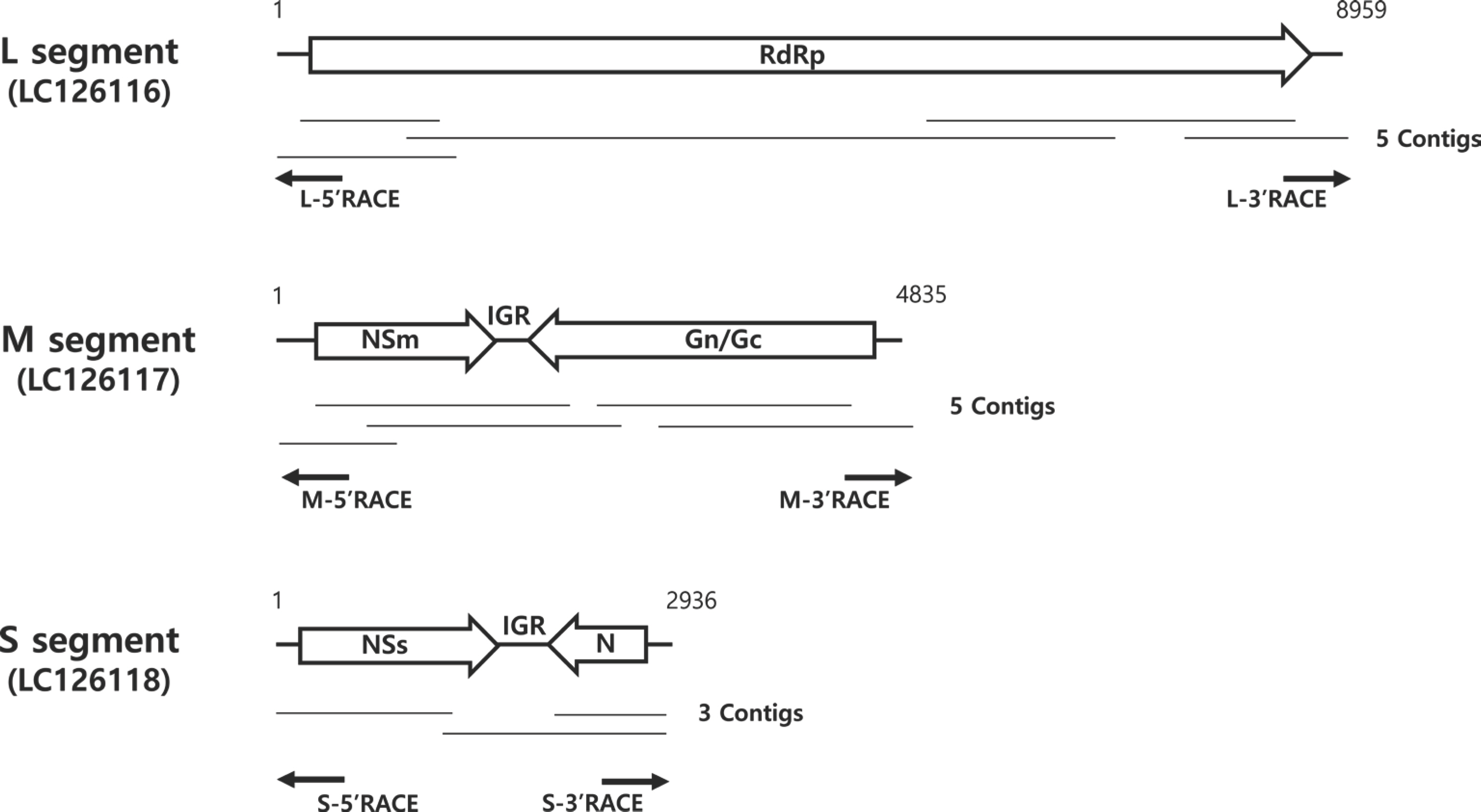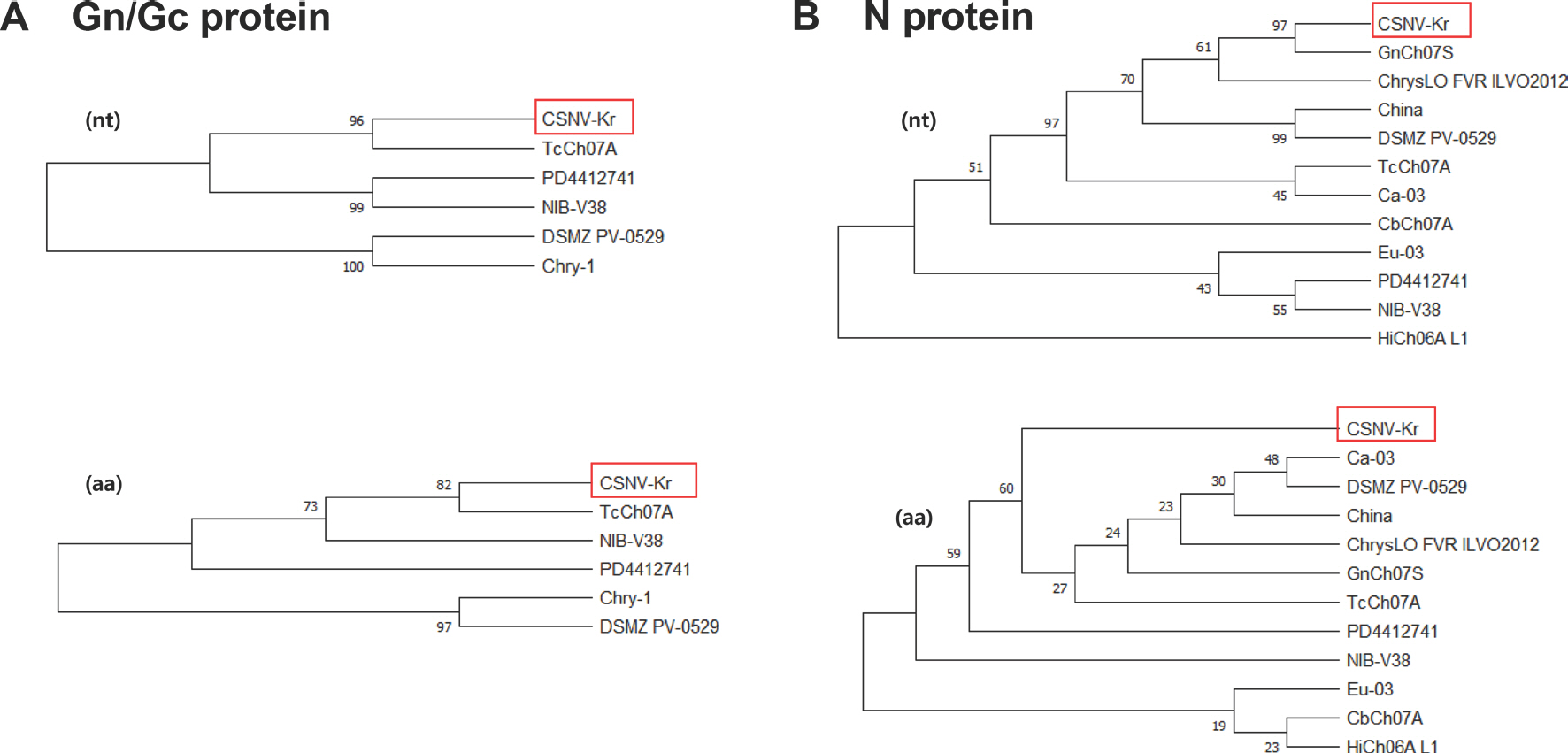Adkins, S., Quadt, R., Choi, T. J., Ahlquist, P. and German, T. 1995. An RNA-dependent RNA polymerase activity associated with viri-ons of tomato spotted wilt virus, a plant-and insect-infecting bunyavirus.
Virology 207: 308-311.


Adkins, S., Turina, M., Whitifield, A., Resende, R., Naidu, R., Hughes, H. et al. 2022. ICTV Code. Rename all existing species to comply with the binomial species format (Bunyavirales: Tospoviridae) TaxoProp 2022.011P. Tospoviridae_rename. URLhttps://ictv.global/taxonomy. [3 August 2023].
Anderson, N. O. 2006. Chrysanthemum. Dendranthema x grandiflo-ra Tzvelv. In: Flower Breeding and Genetics: Issues, Challenges, and Opportunities for the 21st Century, ed. by N. O. Anderson, pp. 389-437. Springer, Dordrecht, The Netherlands.
Bezerra, I. C., Resende, R. de O., Pozzer, L., Nagata, T., Kormelink, R. and De Avila, A. C. 1999. Increase of tospoviral diversity in Brazil with the identification of two new tospovirus species, one from chrysanthemum and one from zucchini.
Phytopathology 89: 823-830.


Boben, J., Mehle, N., Pirc, M., Mavrińć PleŇ°ko, I. and Ravnikar, M. 2007. New molecular diagnostic methods for detection of chrysanthemum stem necrosis virus (CSNV).
Acta Biol. Slovenica 50: 41-51.


Bos, L. 1976. Symptom expression and variation of rose mosaic.
Neth. J. Plant Pathol. 82: 239-249.


Chung, B. N., Pak, H. S., Jung, J. A. and Kim, J. S. 2006. Occurrence of tomato spotted wilt virus in chrysanthemum (
Dendranthema grandiflorum) in Korea.
Plant Pathol. J. 22: 230-234.

Cortez, I., Saaijer, J., Wongjkaew, K. S., Pereira, A. M., Goldbach, R., Peters, D. et al. 2001. Identification and characterization of a novel tospovirus species using a new RT-PCR approach.
Arch. Virol. 146: 265-278.



de Haan, P., Kormelink, R., de Oliveira, R. R., Van Poelwijk, F., Peters, D. and Goldbach, R. 1991. Tomato spotted wilt virus L RNA encodes a putative RNA polymerase.
J. Gen. Virol. 72: 2207-2216.


De Jonghe, K., Morio, S. and Maes, M. 2013. First outbreak of chrysanthemum stem necrosis virus (CSNV) on potted
Chrysanthemum in Belgium.
New Dis. Rep. 28: 14.


Duarte, L. M. L., Alexandre, M. A. V., Gobatto, D., Kitajima, E. W. and Harakava, R. 2014. First report of chrysanthemum stem necrosis virus on Russell prairie gentian in Brazil.
Plant Dis. 98: 285.

Duarte, L. M. L., Rivas, E. B., Alexandre, M. A. V., De √Āvila, A. C., Nagata, T. and Chagas, C. M. 1995. Chrysanthemum stem necrosis caused by a possible novel tospovirus.
J. Phytopathol. 143: 569-571.

Dullemans, A. M., Verhoeven, J. T. J., Kormelink, R. and Van der Vlugt, R. A. A. 2015. The complete nucleotide sequence of chrysanthemum stem necrosis virus.
Arch. Virol. 160: 605-608.



EPPO Datasheet. 2020. PM 7/139 (1) Tospovirus (genus Orthotospovirus). Bull. OEPP/EPPO Bull. 50: 217-240.
Feng, Z., Chen, X., Bao, Y., Dong, J., Zhang, Z. and Tao, X. 2013. Nu-cleocapsid of tomato spotted wilt tospovirus forms mobile par-ticles that traffic on an actin/endoplasmic reticulum network driven by myosin XI-K.
New Phytol. 200: 1212-1224.

Guo, Y., Liu, B., Ding, Z., Li, G., Liu, M., Zhu, D. et al. 2017. Distinct mechanism for the formation of the ribonucleoprotein com-plex of tomato spotted wilt virus.
J. Virol. 91: e00892-17.




Hull, R. 2014. Plant Virology. 5th ed. Academic Press, Elsevier, San Diego, CA, USA. pp. 1104 pp.
Jafarpour, B., Sabokkhiz, M. A. and Rastegar, M. F. 2010. First report of CSNV in Iran and occurrence of some viral diseases of ornamental plants in Mashhad region, Iran. Petria 20: 273.
Jo, Y., Yoon, Y. N., Jang, Y. W., Choi, H., Lee, Y. H., Kim, S. M. et al. 2020. Soybean viromes in the Republic of Korea revealed by RT-PCR and next-generation sequencing.
Microorganisms 8: 1777.



Kikkert, M., Van Lent, J., Storms, M., Bodegom, P., Kormelink, R. and Goldbach, R. 1999. Tomato spotted wilt virus particle morpho-genesis in plant cells.
J. Virol. 73: 2288-2297.




Koonin, E. V., Dolja, V. V., Krupovic, M., Varsani, A., Wolf, Y. I., Yutin, N. et al. 2019. Genus Tospovirus. In: Virus Taxonomy: Eighth Report of the International Committee on the Taxonomy of Viruses, eds. by C. M. Fauquet, M. A. Mayo, J. Maniloff, U. Desselberger and L. A. Ball, pp. 712-716. Elsevier, San Diego, CA, USA.
Kormelink, R., de Haan, P., Meurs, C., Peters, D. and Goldbach, R. 1992. The nucleotide sequence of the M RNA segment of tomato spotted wilt virus, a bunyavirus with two ambisense RNA segments.
J. Gen. Virol. 73: 2795-2804.


Kumar, S., Stecher, G., Li, M., Knyaz, C. and Tamura, K. 2018. MEGA X: molecular evolutionary genetics analysis across computing plantforms.
Mol. Biol. Evol. 35: 1547-1549.


Kuwabara, K. and Sakai, H. 2008. Stem necrosis disease of tomato caused by chrysanthemum necrosis virus (CSNV). Jpn. J. Phytopathol. 74: 225. (abstract in Japanese).
Li, J., Feng, Z., Wu, J., Huang, Y., Lu, G., Zhu, M. et al. 2015. Structure and function analysis of nucleocapsid protein of tomato spotted wilt virus interacting with RNA using homology modeling.
J. Biol. Chem. 290: 3950-3961.



Maris, P. C., Joosten, N. N., Goldbach, R. W. and Peters, D. 2004. Tomato spotted wilt virus infection improves host suitability for its vector. Frankliniella occidentalis. Phytopathology 94: 706-711.
Matsuura, S., Kubota, K. and Okuda, M. 2007. First report of chrysanthemum stem necrosis virus on chrysanthemum in Japan. Plant Dis. 91: 468.
Ministry of Agriculture, Food and Rural Affairs (MAFRA). 2020. Pro-duction of Flower Crops in 2019, in South Korea. Ministry of Agriculture, Food and Rural Affairs (MARFA), Sejong, Korea. pp. 422 pp.
Momonoi, K., Moriwaki, J. and Morikawa, T. 2011. Stem necrosis of aster and Russel prairie gentian caused by chrysanthemum stem necrosis virus.
J. Gen. Plant Pathol. 77: 142-146.


Mumford, R. A., Jarvis, B., Morris, J. and Blockley, A. 2003. First report of chrysanthemum stem necrosis virus (CSNV) in UK. Plant Pathol. 52: 779.
Nagata, T. and De √Āvila, A. C. 2000. Transmission of chrysanthemum stem necrosis virus, a recently discovered tospovirus, by two thrips species.
J. Phytopathol. 148: 123-125.

Nagata, T., Resende, R. de O., Kitajima, E. W., Costa, H., Inoue-Nagata, A. K. and De √Āvila, A. C. 1998. First report of natural occurrence of zucchini lethal chlorosis tospovirus on cucumber and chrysanthemum stem necrosis tospovirus on tomato in Brazil.
Plant Dis. 82: 1403.

Ogada, P. A., Moualeu, D. P. and Poehling, H. M. 2016. Predictive models for tomato spotted wilt virus spread dynamics, consid-ering Frankliniella occidentalis specific life processes as influ-enced by the virus.
PLoS ONE 11: e0154533.



Okuda, S., Okuda, M., Matsuura, S., Okazaki, S. and Iwai, H. 2013. Competence of
Frankliniella occidentalis and
Frankliniella in-tonsa strains as vectors for chrysanthemum stem necrosis virus.
Eur. J. Plant Pathol. 136: 355-362.


Pecman, A., Kutnjak, D., Gutiérrez-Aguirre, I., Adams, I., Fox, A., Boonham, N. et al. 2017. Next generation sequencing for detection and discovery of plant viruses and viroids: comparison of two approaches.
Front. Microbiol. 8: 1998.



Ravnikar, M., Vozelj, N., Mavriè, I., Svigelj, S. D., Zupanèiè, M. and Petroviè, N. 2003. Detection of chrysanthemum stem necrosis virus and tomato spotted wilt virus in chrysanthemum. Ab-stracts 8th International Congress of Plant Pathology. International Society for Plant Pathology, Christchurch, New Zealand.
Ribeiro, D., Foresti, O., Denecke, J., Wellink, J., Goldbach, R. and Kormelink, R. J. M. 2008. Tomato spotted wilt virus glycoproteins induce the formation of endoplasmic reticulum-and Golgi-derived pleomorphic membrane structures in plant cells.
J. Gen. Virol. 89: 1811-1818.


Ribeiro, D., Jung, M., Moling, S., Borst, J. W., Goldbach, R. and Kormelink, R. 2013. The cytosolic nucleoprotein of the plant-infecting bunyavirus tomato spotted wilt recruits endoplasmic reticulum-resident proteins to endoplasmic reticulum export sites.
Plant Cell 25: 3602-3614.



Schnettler, E., Hemmes, H., Huismann, R., Goldbach, R., Prins, M. and Kormelink, R. 2010. Diverging affinity of tospovirus RNA silencing suppressor proteins, NSs, for various RNA duplex molecules.
J. Virol. 84: 11542-11554.




Sin, S. H., McNulty, B. C., Kennedy, G. G. and Moyer, J. W. 2005. Viral genetic determinants for thrips transmission of tomato spotted wilt virus.
Proc. Natl. Acad. Sci. U. S. A. 102: 5168-5173.



Takeda, A., Sugiyama, K., Nagano, H., Mori, M., Kaido, M., Mise, K. et al. 2002. Identification of a novel RNA silencing suppressor, NSs protein of tomato spotted wilt virus.
FEBS Lett. 532: 75-79.



Takeshita, M., Nagai, N., Okuda, M., Matsuura, S., Okuda, S., Furuya, N. et al. 2011. Molecular and biological characterization of chrysanthemum stem necrosis virus isolates from distinct regions in Japan.
Eur. J. Plant Pathol. 131: 9-14.


Trolinger, J. C., McGovern, R. J., Elmer, W. H., Rechcigl, N. A. and Shoemaker, C. M. 2018. Diseases of chrysanthemum. In: Hand-book of Florists’ Crops Diseases, eds. by R. J. McGovern and W. H. Elmer, pp. 439-502. Springer, Cham, Switzerland.

Verhoeven, J. T. J., Roenhorst, J. W., Cortes, I. and Peters, D. 1996. Detection of a novel tospovirus in chrysanthemum.
Acta Hortic. 432: 44-51.

Yoon, J. B., Choi, S. K., Cho, I. S., Kwon, T. R., Yang, C. Y., Seo, M. H. et al. 2020a. Epidemiology of tomato spotted wilt virus in
Chrysanthemum morifolium in South Korea and its management using a soil-dwelling predatory mite (
Stratiolaelaps scimitus) and essential oils.
Virus Res. 289: 198128.


Yoon, J. Y., Choi, G. S. and Choi, S. K. 2017. First report of chrysanthemum stem necrosis virus on
Chrysanthemum morifolium in Korea.
Plant Dis. 101: 264.

Yoon, J. Y., Choi, S. K., Palukaitis, P. and Gray, S. M. 2011.
Agrobacterium-mediated infection of whole plants by yellow dwarf viruses.
Virus Res. 160: 428-434.


Yoon, J. Y., Yoon, J. B., Seo, M. H., Choi, S. K., Cho, I. S., Chung, B. N. et al. 2020b. Application of multiplex RT-PCR for simultaneous identification of tomato spotted wilt virus and thrips species in an individual thrips on chrysanthemum.
Res. Plant Dis. 26: 264-271. (In Korean).








 PDF Links
PDF Links PubReader
PubReader ePub Link
ePub Link Full text via DOI
Full text via DOI Download Citation
Download Citation Print
Print






